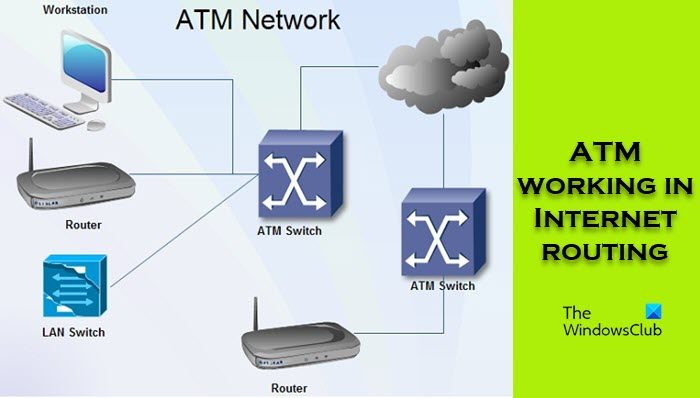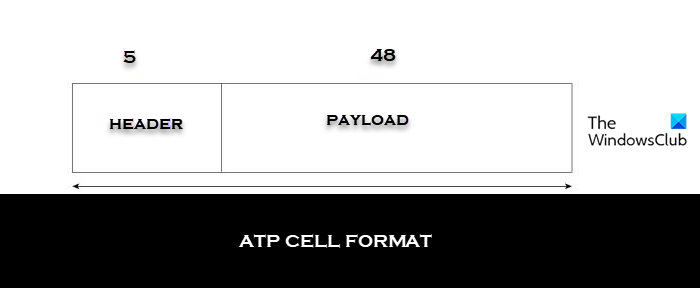Asynchronous Transfer Mode (ATM) is a high-speed, broadband transmission capability technology. It transports various types of user traffic, including telephony (voice), data, and video signals. It operates by dividing data into uniform, 53-byte cells transmitted independently across the network. In this tutorial, we will understand how Asynchronous Transfer Mode works in Internet routing.

How does Asynchronous Transfer Mode work
Asynchronous Transfer Mode (ATM) breaks data into small fixed-size cells. Each cell is 53 bytes long with 48 bytes of data and a 5 bytes header that contains routing information. Old technology, like synchronous systems, follows a strict timing or schedule for data transmission, but in asynchronous, each cell will be sent independently, as needed, without waiting for a specific time slot. To send the data to the destination, the device opens the 5-byte header, which contains information about the source and destination address of the device. Once it verifies the destination address, the cells are correctly routed to their intended destination.
What is the format of the Asynchronous Transfer Mode cell?

ATM will always be in the form of cells with a definite structure. Each cell is 53 bytes long, with a 5-byte header and 48-byte payload. The format of ATP is of the following two types. They can either be UNI Header or HNI Header. The former allows communication between ATM endpoints and switches within the premises of a private network, and it includes the Generic Flow Control (GFC) field. However, the latter doesn’t include GFC as it is by the ATM switches to communicate among themselves, it includes VPI or Virtual Path Identifier.
How does Asynchronous Transfer Mode (ATM) work in Internet routing?
In ATM networks, data is segmented into small fixed-size cells, each of which has a special label called a Virtual Path Identifier (VPI) and a Virtual Channel Identifier (VCI) in its header. The VCI identifies the particular virtual circuit within that virtual channel, whereas the VPI specifies the virtual channel to which the cell belongs. These labels were essential for routing the data. This technology established connections using Virtual Paths (VP) and Virtual Channels (VC).
Virtual Path comprised several Virtual Channels, each of which acted as a specific channel for data transmission between two endpoints in the ATM network. In this technology, routing was connection-oriented, which meant that a route had to be created before data could be transmitted over the network. When any device wants to transmit data over a network to another, it first needs to establish a connection by signaling through the network and setting up the appropriate Virtual Path (VP) and Virtual Circuit (VC). Routing decisions were taken at network nodes based on the Virtual Path Identifier (VPI) and Virtual Channel Identifier (VCI) details in the cell headers.
Read: What are best free Computer-assisted Translation (CAT) AI Tools?
Explain the Virtual Path Identifier (VPI) and Virtual Channel Identifier (VCI)
Virtual Path Identifier (VPI) is an 8- or 12-bit field in an ATM cell header. It’s used to identify the path a cell should take within an ATM network. VPI values range from 0 to 4095, with VPI=0 reserved for the null path. In essence, the VPI acts like a highway number for the cell, guiding it through the network’s virtual pathways.
Virtual Channel Identifier (VCI), on the other hand, is another 16-bit field in the ATM cell header. It further specifies the endpoint within the path defined by the VPI. VCI values range from 0 to 65535, and they ensure that the cell reaches the exact destination on the chosen path.
That’s it!
Read: Biometric security, potential threats to it and their solutions
Where is Asynchronous Transfer Mode used?
Asynchronous Transfer Mode or ATM is used in optical networking and synchronous digital hierarchy (SONET/SDH) which is a cornerstone of public switched telephone networks and in the Integrated Services Digital Network (ISDN). It is best suited in those circumstances due to the fact it uses bandwidth at maximum efficiency while maintaining a guaranteed quality of service (QoS) for users and applications that require it.
Read: What is SSL Stripping attack? How to prevent it?
What is the difference between Asynchronous Transfer Mode and Ethernet?
The main difference between them is that ATM has fixed-length cells of 53 bytes whereas, Ethernet has frames of variable length. Also, ATM is a connection-based protocol whereas, Ethernet is a connectionless protocol. On one hand, ATM uses cell or packet switching, and virtual circuits switch the transmission medium, on the other, Ethernet uses packet switching to transmit data over a network.
Read Next: Best free SSH Clients for Windows.
Leave a Reply